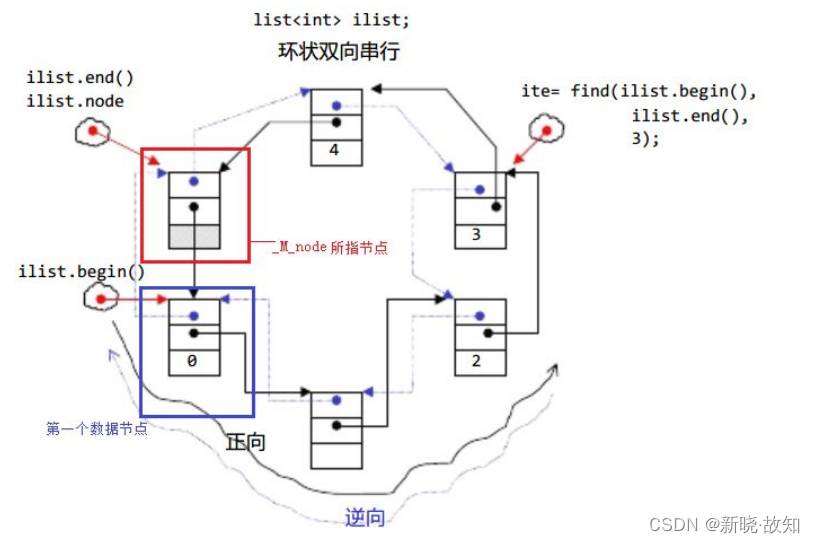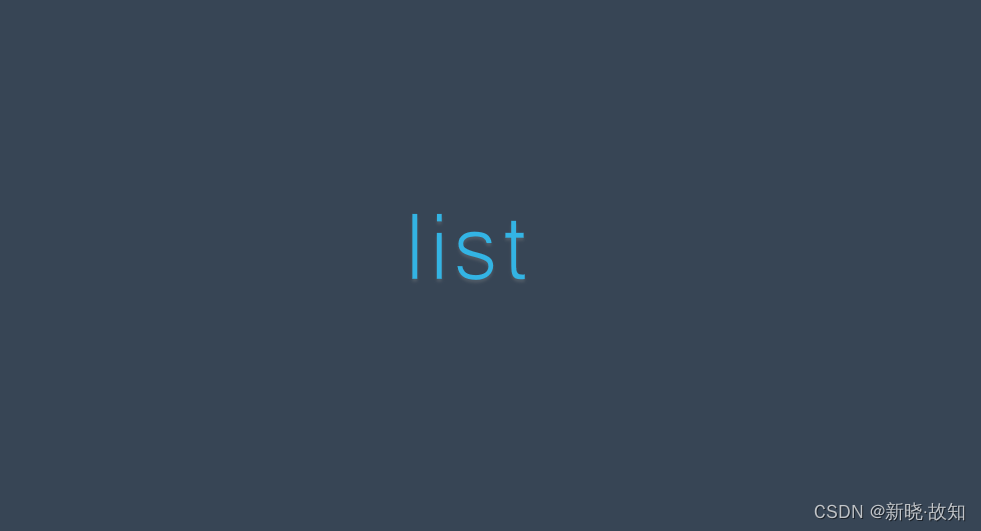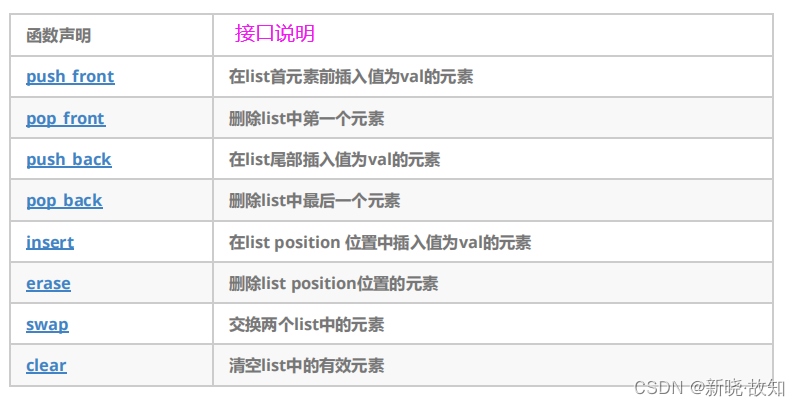目录
后记:●由于作者水平有限,文章难免存在谬误之处,敬请读者斧正,俚语成篇,恳望指教! ——By 作者:新晓·故知
1. list的介绍及使用
1.1 list的介绍
list的文档介绍链接:list - C++ Reference1. list是可以在常数范围内在任意位置进行插入和删除的序列式容器,并且该容器可以前后双向迭代。2. list的底层是双向链表结构,双向链表中每个元素存储在互不相关的独立节点中,在节点中通过指针指向其前一个元素和后一个元素。3. list与forward_list非常相似:最主要的不同在于forward_list是单链表,只能朝前迭代,已让其更简单高效。4. 与其他的序列式容器相比(array,vector,deque),list通常在任意位置进行插入、移除元素的执行效率更好。5. 与其他序列式容器相比,list和forward_list最大的缺陷是不支持任意位置的随机访问,比如:要访问list的第6个元素,必须从已知的位置(比如头部或者尾部)迭代到该位置,在这段位置上迭代需要线性的时间开销;list还需要一些额外的空间,以保存每个节点的相关联信息(对于存储类型较小元素的大list来说这可能是一个重要的因素)
1.2 list的使用
list中的接口比较多,此处类似,只需要掌握如何正确的使用,然后再去深入研究背后的原理,已达到可扩展的能力。以下为list中一些常见的重要接口
1.2.1 list的构造
拷贝构造函数 // constructing lists #include <iostream> #include <list> using namespace std; int main() { std::list<int> l1; // 构造空的l1 std::list<int> l2(4, 100); // l2中放4个值为100的元素 std::list<int> l3(l2.begin(), l2.end()); // 用l2的[begin(), end())左闭右开的区间构造l3 std::list<int> l4(l3); // 用l3拷贝构造l4 // 以数组为迭代器区间构造l5 int array[] = { 16,2,77,29 }; std::list<int> l5(array, array + sizeof(array) / sizeof(int)); // 用迭代器方式打印l5中的元素 for (std::list<int>::iterator it = l5.begin(); it != l5.end(); it++) std::cout << *it << " "; std::cout << endl; // C++11范围for的方式遍历 for (auto& e : l5) std::cout << e << " "; std::cout << endl; return 0; }
1.2.2 list iterator的使用
此处,大家可暂时将迭代器理解成一个指针,该指针指向list中的某个节点
【注意】1. begin与end为正向迭代器,对迭代器执行++操作,迭代器向后移动2. rbegin(end)与rend(begin)为反向迭代器,对迭代器执行++操作,迭代器向前移动#include <iostream> using namespace std; #include <list> void print_list(const list<int>& l) { // 注意这里调用的是list的 begin() const,返回list的const_iterator对象 for (list<int>::const_iterator it = l.begin(); it != l.end(); ++it) { cout << *it << " "; // *it = 10; 编译不通过 } cout << endl; } int main() { int array[] = { 1, 2, 3, 4, 5, 6, 7, 8, 9, 0 }; list<int> l(array, array + sizeof(array) / sizeof(array[0])); // 使用正向迭代器正向list中的元素 for (list<int>::iterator it = l.begin(); it != l.end(); ++it) cout << *it << " "; cout << endl; // 使用反向迭代器逆向打印list中的元素 for (list<int>::reverse_iterator it = l.rbegin(); it != l.rend(); ++it) cout << *it << " "; cout << endl; return 0; }实现结构的角度,迭代器分为三类:
1.单向迭代器:支持++ 例:forward_list、unordered_map、unordered_set
2.双向迭代器:支持++、-- 例:list、map、set
3.随机迭代器:支持++、--、+、- 例:vector、string、deque
1.2.3 list capacity
1.2.4 list element access
1.2.5 list modififiers
#include <list> void PrintList(list<int>& l) { for (auto& e : l) cout << e << " "; cout << endl; } //========================================================================================= // push_back/pop_back/push_front/pop_front void TestList1() { int array[] = { 1, 2, 3 }; list<int> L(array, array + sizeof(array) / sizeof(array[0])); // 在list的尾部插入4,头部插入0 L.push_back(4); L.push_front(0); PrintList(L); // 删除list尾部节点和头部节点 L.pop_back(); L.pop_front(); PrintList(L); } //========================================================================================= // insert /erase void TestList3() { int array1[] = { 1, 2, 3 }; list<int> L(array1, array1 + sizeof(array1) / sizeof(array1[0])); // 获取链表中第二个节点 auto pos = ++L.begin(); cout << *pos << endl; // 在pos前插入值为4的元素 L.insert(pos, 4); PrintList(L); // 在pos前插入5个值为5的元素 L.insert(pos, 5, 5); PrintList(L); // 在pos前插入[v.begin(), v.end)区间中的元素 vector<int> v{ 7, 8, 9 }; L.insert(pos, v.begin(), v.end()); PrintList(L); // 删除pos位置上的元素 L.erase(pos); PrintList(L); // 删除list中[begin, end)区间中的元素,即删除list中的所有元素 L.erase(L.begin(), L.end()); PrintList(L); } // resize/swap/clear void TestList4() { // 用数组来构造list int array1[] = { 1, 2, 3 }; list<int> l1(array1, array1 + sizeof(array1) / sizeof(array1[0])); PrintList(l1); // 交换l1和l2中的元素 l1.swap(l2); PrintList(l1); PrintList(l2); // 将l2中的元素清空 l2.clear(); cout << l2.size() << endl; }list中还有一些操作,需要用到时大家可参阅list的文档说明。
1.2.6 list的迭代器失效
前面说过,此处大家可将迭代器暂时理解成类似于指针,迭代器失效即迭代器所指向的节点的无效,即该节 点被删除了。因为list的底层结构为带头结点的双向循环链表,因此在list中进行插入时是不会导致list的迭代 器失效的,只有在删除时才会失效,并且失效的只是指向被删除节点的迭代器,其他迭代器不会受到影响 。void TestListIterator1() { int array[] = { 1, 2, 3, 4, 5, 6, 7, 8, 9, 0 }; list<int> l(array, array + sizeof(array) / sizeof(array[0])); auto it = l.begin(); while (it != l.end()) { // erase()函数执行后,it所指向的节点已被删除,因此it无效,在下一次使用it时,必须先给 其赋值 l.erase(it); ++it; } } // 改正 void TestListIterator() { int array[] = { 1, 2, 3, 4, 5, 6, 7, 8, 9, 0 }; list<int> l(array, array + sizeof(array) / sizeof(array[0])); auto it = l.begin(); while (it != l.end()) { l.erase(it++); // it = l.erase(it); } }常用接口测试:
#include<iostream> #include<list> using namespace std; void TestList1() { list<int> lt; lt.push_back(1); lt.push_back(2); lt.push_back(3); lt.push_back(4); /*for (auto e : lt) { cout << e << " "; } cout << endl;*/ list<int>::iterator it = lt.begin(); //正向迭代器 while (it != lt.end()) { cout << *it << " "; ++it; } cout << endl; } void TestList2() { list<int> lt; lt.push_back(1); lt.push_back(2); lt.push_back(3); lt.push_back(4); list<int>::reverse_iterator rit = lt.rbegin(); //反向迭代器 while (rit != lt.rend()) { cout << *rit << " "; ++rit; } cout << endl; } void TestList3() { list<int> lt; lt.push_back(1); lt.push_back(2); lt.push_back(3); lt.push_back(4); for (auto e : lt) { cout << e << " "; } cout << endl; lt.push_front(5); lt.push_front(6); lt.push_front(7); for (auto e : lt) { cout << e << " "; } cout << endl; lt.pop_back(); lt.pop_back(); for (auto e : lt) { cout << e << " "; } cout << endl; lt.pop_front(); lt.pop_front(); for (auto e : lt) { cout << e << " "; } cout << endl; } void TestList4() { list<int> lt; lt.push_back(6); lt.push_back(2); lt.push_back(8); lt.push_back(4); for (auto e : lt) { cout << e << " "; } cout << endl; lt.sort(); for (auto e : lt) { cout << e << " "; } } void TestList5() { list<int> lt; lt.push_back(6); lt.push_back(4); lt.push_back(2); lt.push_back(8); lt.push_back(4); lt.push_back(4); for (auto e : lt) { cout << e << " "; } cout << endl; lt.sort(); //排序 for (auto e : lt) { cout << e << " "; } cout << endl; lt.unique(); //需先排序,再去重 for (auto e : lt) { cout << e << " "; } cout << endl; } int main() { //TestList1(); //TestList2(); //TestList3(); //TestList4(); TestList5(); return 0; }

























 343
343











 被折叠的 条评论
为什么被折叠?
被折叠的 条评论
为什么被折叠?








